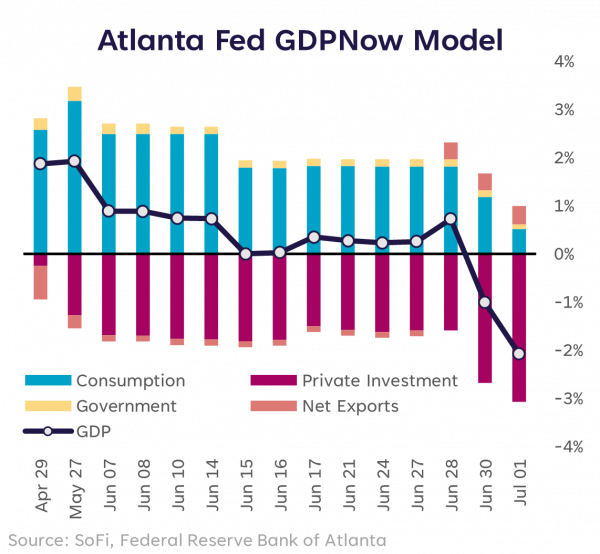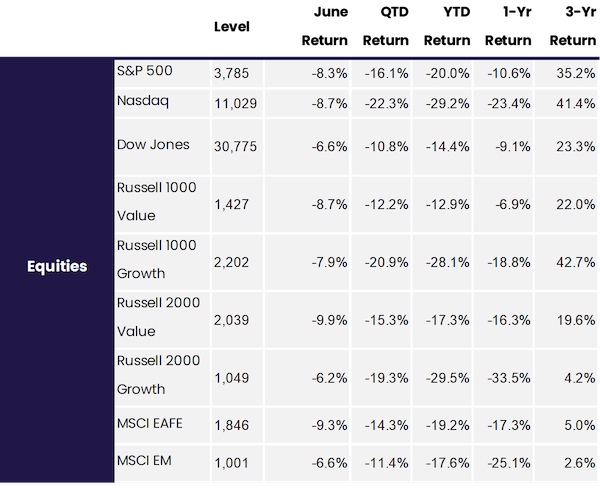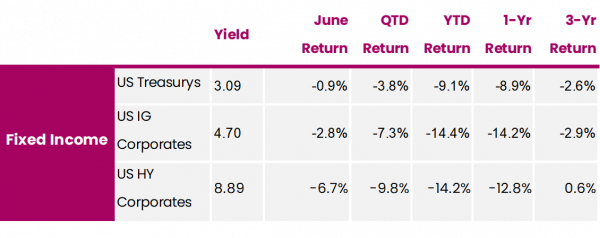June 2022 Market Lookback
Recession Angst Intensifying
While performance across most assets has been less than inspiring thus far in 2022, there’s been a notable tone shift of late. Whereas inflation and monetary policy were the primary market drivers for much of the year, recession fears have been picking up. Economic data is showing signs of cooling, with the Atlanta Fed’s GDPNow model estimating Q2 real GDP growth of -2.1%.
Such an outcome would be the second consecutive quarter of negative GDP growth, which would indicate recession. However, just like in Q1 when a decline in Net Exports weighed down GDP, Q2 is expected to be dragged down by the “Change in Inventories” component of Private Investment—the Atlanta Fed’s model estimates that inventories will shave 2.4% off Q2 GDP. In other words, GDP growth would be slightly positive without the drag from inventories.
Despite excess savings and a historically tight labor market, consumer spending is starting to crack under the immense pressure of inflation. As late as Jun 28, the model had consumption adding 1.8% to GDP—three days later and its expected contribution to GDP fell to 0.5%.

Crypto Winter In Full Effect
It appeared as if things couldn’t get much worse for cryptos in May, yet that’s exactly what happened in June. Spurred by the collapse of the TerraUSD algorithmic stablecoin and the general tightening of financial conditions, capital has been fleeing from DeFi (decentralized finance) lenders and the crypto space overall. These capital outflows continued in June, with numerous lenders eventually pausing withdrawals because liquidity dried up.
Just like significant debt can amplify returns in a bull market, debt amplifies losses in a bear. Many investors were forced to liquidate their positions as the price of cryptos fell, which snowballed into further price declines and liquidations. Total Value Locked, a measure of how much money is deposited in the DeFi space, is down 34% since the end of May and 69% YTD. It’s unclear if this negative feedback loop has run its course, but the fallout has been meaningful.

With the rapid sell-off and forced liquidations that took hold in June, a big pullback in price was unavoidable. Most cryptos lost an additional 40-50% in June, after having already been down 30-40% for 2022 at the start of the month.
Macro
• The unemployment rate remained at 3.6% in May, above the consensus of 3.5%.
• CPI in May accelerated to 8.6% y/y and 1.0% m/m, an upside surprise driven by high energy costs and a broadening of services inflation.
• In response to fears of rising inflation expectations, the Fed hiked rates by 75bps on Jun 15.
• 30-Yr fixed mortgage rates reached 6.04% on Jun 21, the highest level since 2008.
• Oil prices peaked at $122/barrel on Jun 8, before sharply falling to $104 on Jun 23 as demand concerns intensified.


Equities
• Global stocks broadly sold off in Jun, as investor fears pivoted from inflation to potential recession.
• Growth stocks slightly outperformed value stocks due to their perceived resilience during times of slowing growth.
• Defensives continued to outperform as investors rotated toward less risky, higher quality areas of the market.
• Tracking oil prices, Energy peaked on Jun 8 before declining 23% through Jun 24, its sharpest drawdown since Mar 2020.

Fixed Income
• Interest rate volatility was elevated for much of the month—starting the month at ~2.90%, 10-Yr Treasury yields rose to ~3.50% mid-Jun before declining to 3.01% at the end of the month.
• Shorter-term interest rates increased more than longer-term rates, buoyed by expectations of aggressive Fed rate hikes.
• Credit spread widening continued in Jun, with spreads between government and high yield bonds now at their highest since mid-2020.

Crypto
• Insolvency issues among crypto lenders led to a wave of defaults and liquidations, leading to record losses in the month of Jun.
• Bitcoin’s -59.1% quarterly return was its worst since 2011, while Ethereum’s -69.4% quarterly return was its worst ever.
Performance data quoted represents past performance. Past performance does not guarantee future results. Market returns will fluctuate, and current performance may be lower or higher than the standardized performance data quoted.
Photo credit: iStock/MicroPixieStock
Comments are closed.